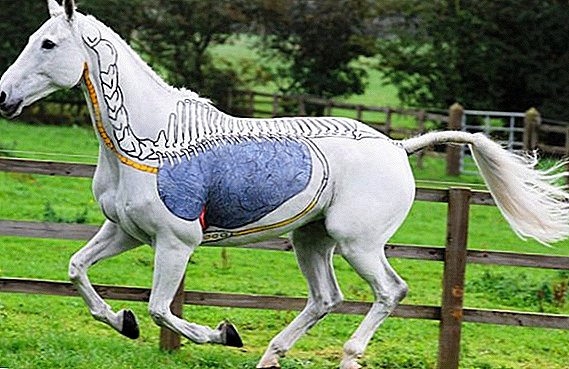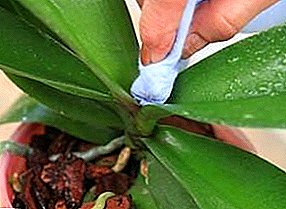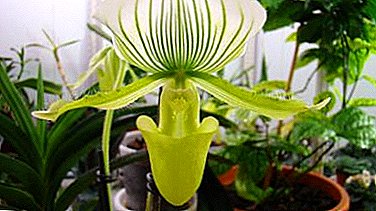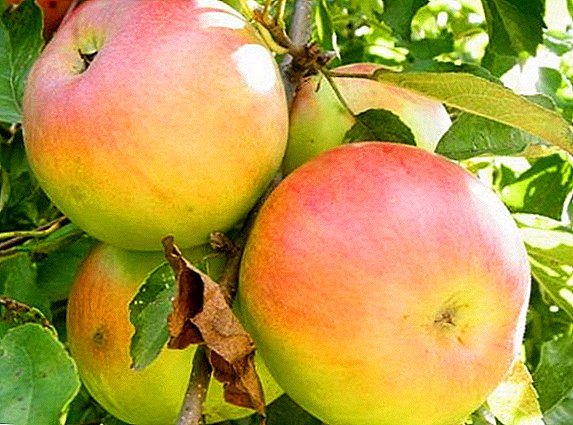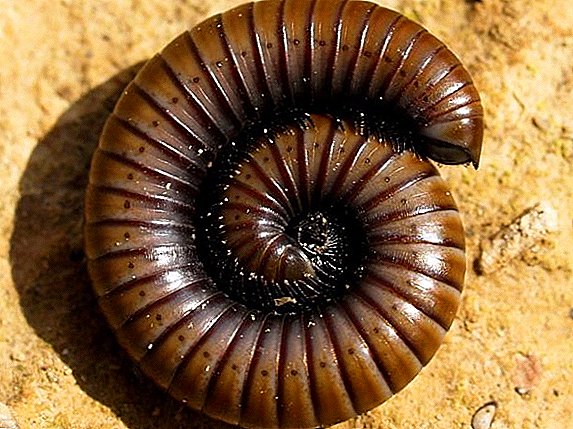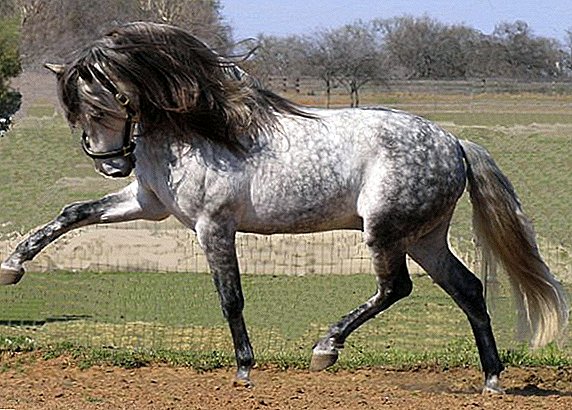 Today we will tell you about an interesting breed of horses that has left its mark in the history of Europe, and has also been mentioned in many books of famous writers. Learn about Andalusian strengths and standards, as well as use in various fields.
Today we will tell you about an interesting breed of horses that has left its mark in the history of Europe, and has also been mentioned in many books of famous writers. Learn about Andalusian strengths and standards, as well as use in various fields.
The history of the "glorious" horse
Homeland Andalusian horse is Spain, namely - the province of Andalusia, in whose honor the breed got its name. The Iberian horses of Portugal and Spain are considered ancestors.
Grandparents are horses whose cave paintings date back to 2-3 millennium BC. uh ... These drawings are found in caves in the south of Spain, which confirms that the breed belongs to this country.
Learn more about the features of breeding the smallest breed of horses - a pony, and the largest breed - Shire.
In the 15th century, the Andalusians became one of the most sought-after horses in the armies of Europe, as they were responsive in management, and also distinguished by dexterity from their "brothers". It was at that time that the stud farms were established at the monasteries, where the Cartesian monks were engaged in breeding and controlling purity.
Until 1962, representatives of this breed were not sold outside of Spain, one during the occupation of Spain by Napoleon, not a small part of the Andalusians were hijacked to France.  Currently, this breed is used in riding schools, where it helps beginners to get used to the animal and the management of the horse. Andalusians are distinguished by obedience, dexterity, grace and intelligence. They are used in equestrian sports, and also participate in parades.
Currently, this breed is used in riding schools, where it helps beginners to get used to the animal and the management of the horse. Andalusians are distinguished by obedience, dexterity, grace and intelligence. They are used in equestrian sports, and also participate in parades.
Did you know? A tired horse begins to ride on his back. Such an activity is considered a kind of massage, which helps to improve blood circulation, as well as stretch the muscles.
External data
- Growth - 155-161 cm (withers).
- Weight - 545-590 kg.
- Lifespan - 25 years.
- Using - for dressage, for training, like a circus horse.
Exterior:
- Head small in size, forehead wide, ears set high. The eyes are large, expressive, almond-shaped. The nose is straight or with a small hump.
- Neck fairly long, muscular, well set, with a slight bend.
- Torso small, rounded. Withers wide, well marked.
- Back slightly concave, strong, have developed muscles.
- Chest wide.
- Croup wide, short.
- Tail set low, long, thick, often wavy.
- Mane very thick and voluminous.
- Limbs do not differ in length, but not very short. The musculature is well developed. The legs are dry, the joints stand out well.
- Hooves small in size, quite high.

Character and temper
This breed of horses is distinguished not only by physical characteristics and beautiful appearance, but also by attitude to man. They do not just listen and do the work, but they live by it. Andalusians like to spend time with a person, perform assigned tasks, and learn something new. It is for this reason that the breed is in demand in circuses, where the horse is required to perform unambiguous complex actions.
You will probably be interested to learn how to harness horses correctly.
Andalusian, like a shepherd dog, requires respect and perseverance from the owner, while not accepting threats or physical punishment. The horse has a proud character that you have to reckon with.
Suits
By standard, the Spanish breed has no suit restrictions. This means that if a horse conforms to all standards, then the color does not matter, and the individual is purebred.
At the same time, about 80% of all Andalusians have gray color of wool, and the remaining 20% include a wide variety of colors and shades: bay, black, dun, red, and isabella.
Important! The color of the mane may differ from the general color of the body, which is also not considered a defect.

Learn more about horses of the Karachai, Friesian, Appaloosa, Trakeneen, Vladimir heavy-weight, Arabian horses.
"Black" days of the breed
If during the Napoleonic wars, the Andalusians were on the verge of annihilation due to mixing with horses of other breeds, in 1832, most of the representatives died from an epidemic. Only one herd survived, thanks to which they were able to resume the population.
Even before the mass extinction of the epidemic, the breed has sharply lost its popularity, as the English thoroughbreds became popular. Andalusian horses at the time became too costly, and their strengths - useless.
At the beginning of the 20th century, a standard was described, and a pedigree book was introduced, which allowed not only to keep records of individuals, but also to monitor the purity of the breed. Also from this point on, work began on "cleaning" blood from Arabic impurities that arose during the period of experiments for military needs.
Important! In Portugal, the Andalusians were called the Lusitanian horse, although in fact it is one breed both in appearance and standards.

Check out the ranking of the best horse suits.
What breeds were bred on its basis
- Lipicans
- English Cleveland bay.
- Irish Connemara.
- German warm-blooded.
- Peruvian paso.
- Quarterhos
Equestrian use
Andalusians are used in the following equestrian sports:
- jumping;
- dressage;
- trail;
- driving;
- Riding (classic and western).
Breeding
Despite the fact that the breed has been freely bred outside Spain for over 50 years, the main breeders and sellers are located exactly in their homeland. The main population is focused on the historic homeland in Andalusia.  Animals are kept in harsh conditions when it is not about providing comfortable conditions, but about hardening. Mares year-round graze in the meadows, even while reducing the air temperature.
Animals are kept in harsh conditions when it is not about providing comfortable conditions, but about hardening. Mares year-round graze in the meadows, even while reducing the air temperature.
Since the stallions are designed for riding, their castration is not carried out. When used in harness, 5 strong horses are selected (three in the front and two in the rear).
Did you know? Despite the fact that the hoof is a horny tissue that is similar in composition to the nails, they have excellent sensitivity. Also hoofs are responsible for blood circulation.An Andalusian horse is valuable when used in sports or at exhibitions, but it is not suitable as a working horse. Given the value of a purebred individual, it is worth acquiring it either for further breeding or for various shows where it will justify the costs.





